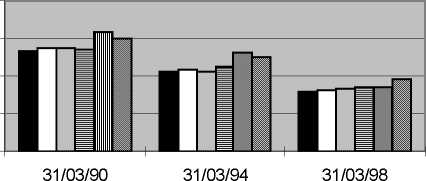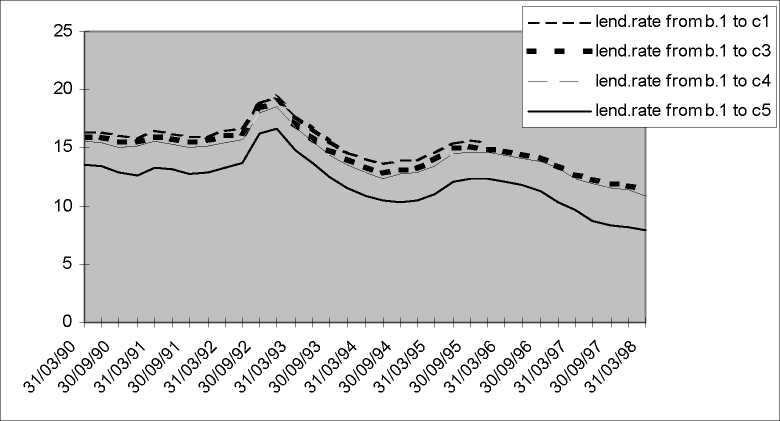Lend. rates to loan size class "c5" by area from
small and minor banks
■D
C
φ
20
15
10
5
0

■ area 1
□ area 2
U area 3
■ area 4
И area 5
И area 6
A very precise pattern, on the contrary is detectable in the behaviour of interest rates according to
the different class sizes of loans in the various geographic areas (as observed for each given lender size
class). In particular, the relation between the loan size class and the level of the interest rate is particularly
evident if one compares the interest rate level between the loan class “C5” and the other categories. In
addition, the interest rate to she smaller class size of loans is constantly higher than the interest rate to the
other classes. An exception to this apparent negative relation between loan size class and lending rates is
given by the lending rates from average size banks (B2) in areas 3, 5, 6 and from small and minor banks
(B3) in “area 5” where the negative relation between lending rate and loan size does not exist for the
intermediate size classes of loans, although it still exists between those and the two extreme loan size
classes. All these data would be confirmed, and be also more evident in the descriptive statistical tables
of the appendix.
Of course, the relation between loan size and level of lending rate might just be apparent and
explained by different theoretical variables, such as risk and demand expectations: this is shown in the
very simple econometric analysis of the next sections, where the estimates with proxies “capturing” risk
and the different market power of lenders and borrowers yield completely non-significant dummies for the
loan size classes, in spite of what seems to appear from the graphics.

13
AREA 1
More intriguing information
1. How we might be able to understand the brain2. The name is absent
3. How do investors' expectations drive asset prices?
4. Locke's theory of perception
5. The Role of Land Retirement Programs for Management of Water Resources
6. Effects of red light and loud noise on the rate at which monkeys sample the sensory environment
7. A dynamic approach to the tendency of industries to cluster
8. Ein pragmatisierter Kalkul des naturlichen Schlieβens nebst Metatheorie
9. The name is absent
10. The name is absent